U.S. Department of Transportation
Federal Highway Administration
1200 New Jersey Avenue, SE
Washington, DC 20590
202-366-4000
Federal Highway Administration Research and Technology
Coordinating, Developing, and Delivering Highway Transportation Innovations
|
Research & Technology Transporter This newsletter is an archived publication and may contain dated technical, contact, and link information. |
|
| Publication Number: N/A Date: April 1998 |
Publication Date: April 1998
|
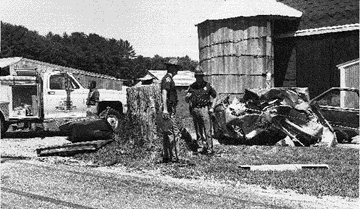
Information that will assist highway safety professionals in making better decisions about collecting and managing safety data has recently been published by FHWA. The main report, Highway Safety Data: Costs, Quality, and Strategies for Improvement (FHWA-RD-96-192), examines the collection and management of highway safety data by discussing issues and costs, and proposing means of resolving those issues and reducing the costs.
Each year $130 million is spent nationwide on data collection and management. The report presents three types of strategies that will reduce these costs. The first is readily implemented strategies including improving data collection instruments and improving data collection processes. The second concerns technological advancement strategies including maximizing automated data collection and automated data management. The third type are longer range strategies including decreasing reliance on patrol officers for collecting crash data and applying reengineering methods to data collection and management.
Other information in the report documents current processes and costs for collecting and managing safety data in several State and local agencies. The information is presented so that other agencies can make comparisons to better assess their work and expenditures. Typical problems faced by a number of agencies in maintaining the quality of safety data is also included, along with noteworthy practices to address these problems.
An Executive Summary (FHWA-RD-96-027) to the main report provides a summary of the final report regarding the costs and quality of highway safety data and strategies to improve the data. The main report and executive summary can be obtained from FHWA's Report Center by calling (301) 577-0906. A background report, Highway Safety Data: Costs, Quality, and Strategies for Improvement, Research Report (FHWA-RD-96-191), presents the final report material in much greater detail. It can be obtained from the National Technical Information Service by calling (703) 487-4650.
- Michael S. Griffith, (202) 493-3316, mike.griffith@fhwa.dot.gov
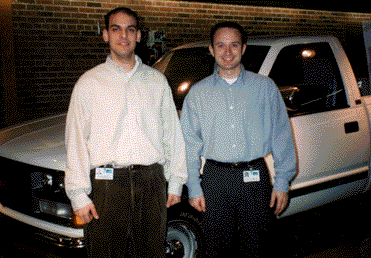
The knowledge that students gain and use at the FHWA/NHTSA National Crash Analysis Center (NCAC) pays off. After gaining valuable experience through their research at NCAC, graduate students Nicholas Tamborra and George Bahouth have taken on active roles in their internships at General Motors and in the automotive industry. They are being assigned advanced tasks in their internships which is a sign that the highly practical research they were part of at NCAC paid off.
After working in vehicle model development for the NCAC Vehicle Digitization Laboratory, Nick Tambora is spending time at GM working with vehicle models at the Luxury Car Division Flint, MI. He has been involved already in model development and validation to improve vehicle crash worthiness. George Bahouth, who now works at the GM Technical Center in Warren, MI, is applying his knowledge of biomechanics and occupant safety to improve vehicle crashworthiness for the Midsize Car Group. He is focusing on lower limb protection for vehicles at various stages of design.
Both students are completing the internships to fulfill requirements for their Masters program at the George Washington University. They are returning to NCAC this spring to complete their studies. Specially adapted to provide students with a broad base of knowledge in the area of transportation safety, the degree program includes study of finite element analysis, vehicle dynamics, accident investigation, and biomechanics. These courses are offered in addition to a traditional graduate level curriculum in Mechanical Engineering. The internship program is part of the formal education of the graduate students of the NCAC.
- Leonard Meczkowski, (202) 493-3317, leonard.meczkowski@fhwa.dot.gov
Work zone incidents have resulted in a yearly average of approximately 700 to 800 deaths and 5,000 injuries, imposing an economic cost exceeding $3 billion annually. In an effort to significantly reduce these numbers, the National Work Zone Safety Information Clearinghouse was opened on February 17 by FHWA and the American Road and Transportation Builders Association (ARTBA). The Clearinghouse is a resource center for improving the quality of temporary traffic control at highway construction sites, and for decreasing fatalities, injuries, and property damage that take place in work zones. Anyone who is interested in reducing these deaths, injuries, and costs will be able to find the latest information at the Clearinghouse on how to develop and implement safer work zones.
After years of public discussion and expression of concern regarding work zone safety and expense, the Clearinghouse will, for the first time, provide comprehensive information and resources to highway designers, contractors, safety officials, supervisors, insurance companies, and researchers. Information available from the Clearinghouse will include workzone-related statistics, public education and outreach, safety products, research reports, laws, regulations, training courses, and specifications. Identifying key experts in each of these areas will be a special focus. Trained researchers at the Clearinghouse will be able to take requests by mail, telephone, fax, or e-mail. The project includes a site on the web. The goal will be to provide information within 24 hours for telephone and electronic requests. Calls requiring a written response or needing more research will take longer.
ARTBA and its partner the Texas Transportation Institute (TTI) will establish and operate the Clearinghouse under a 3-year contract with FHWA. Most services by the Clearinghouse will be provided at no cost. To contact the Clearinghouse, call (888) 447-5556 or visit its Web site at wzsafety.tamu.edu.
- Paul Harker, (202) 366-2195,paul.harker@fhwa.dot.gov
FHWA in partnership with 21 State DOTs is trying to improving safety in work zones with the release of a new outreach campaign. The campaign message is: "Don't risk your life because you don't get the picture - be alert, slow down, and pay attention to the signs!" The Office of Highway Safety is pleased to announce that the campaign, entitled Get The Picture. Listen To The Signs, is being distributed to State public affairs officers in all 50 States, plus D.C. and Puerto Rico.

The multimedia campaign features 3D animation in two 30-second television ads featuring a flagger symbol that morphs out of a sign into an orange and black world of work zones to become a "Flagger Superhero." The campaign also contains three entertaining and educational 60-second radio ads, brochure, poster, bumper sticker, media kit, and tips on how to use the media kit. Each campaign component is designed so each State DOT can add their own logo and tag line.
Focus group studies revealed that many drivers either don't understand road construction warning signs, don't understand how they should react to the signs, or just don't pay attention to the signs. Many of today's motorist aren't concerned about worker safety and respond more to a "what's in it for me" approach. In addition, we found that most people don't understand the magnitude of the work zone safety problem in terms of annual deaths and injuries to both motorists and workers. Therefore, the campaign goals are to educate the public on the meaning of the signs and to alert motorists on the potential hazards of work zones for the traveling public.
- Ann Walls, (202) 366-6836, ann.walls@fhwa.dot.gov
The U.S. Department of Transportation (DOT) is teaming up with the Environmental Protection Agency (EPA) to initiate pilot programs aimed at enhancing public involvement in voluntary behavior changes that reduce congestion and improve air quality. The two agencies have selected three cities to participate in the pilot program, which they expect to launch in May, the beginning of the year's ozone season. The program may be expanded to include as many as 25 other cities in the 1999 ozone season after evaluating the success of the initial pilot projects.
Officials with EPA's Office of Mobile Sources and U.S. DOT's Federal Highway and Transit Administrations will be working with State and local organizations in Dover, DE, Milwaukee, WI, and San Francisco, CA, to support efforts to meet congestion and air quality goals under the Intermodal Surface Transportation Efficiency Act and the Clean Air Act. The primary goal of the project is to build national and local coalitions of public and private organizations geared toward changing attitudes and behaviors related to transportation and air quality.
The initiative seeks to improve the efficiency of current programs and develop a community-based effort that is self-sustaining by bringing private-sector resources to support public outreach efforts. The four components of the initiative are pilot tests, coalition building, outreach, and evaluation of the program.
Federal agencies have been gathering data over the last few years in preparation for this public outreach initiative and are now completing information packages customized for each city in the pilot study. These information packages include radio, TV, and print advertisements that encourage people to maintain their cars, link their automobile trips, and use alternative modes of transportation. In addition, pilot sites will be given technical assistance and limited funding for local public outreach initiatives.
Programs designed to involve the community in improving air quality are prevalent across the country, but local governments sometimes have difficulty sustaining these programs from one ozone season to the next. The DOT/EPA project aims to add longevity to programs geared toward cleaner air. One of the goals of the project is to encourage the public to consider alternative transportation modes on a routine basis and not just during high-ozone episodes.
The Federal agencies are in the initial stages of identifying potential national coalition members to help ensure the expansion and sustainability of the initiative. These organizations may include: transportation and air quality groups, regional and State government programs, environmental organizations, businesses and manufacturers, energy and auto industry groups, and medical and public health organizations.
Each of the three pilot cities has different needs based on different air quality problems, varying levels of public awareness, and different available options. Each site is expected to prepare a customized plan based on these varying needs. The results of the three pilot studies will be evaluated in the fall to assess their potential for long-term effectiveness.
DOT and EPA expect to release results of the initial pilot in late 1998 and begin evaluating the potential to expand the project to 25 other cities. New sites will be chosen based on a number of criteria, including their ability to sustain transportation choices that lead to congestion mitigation and improved air quality over the long term.
For more information, visit:
- Kathleen Daniel, (202) 366-6276, kathleen.daniel@fhwa.dot.gov
A new highway traffic noise model that will save taxpayers as much as $20 million a year... An innovative, time-saving method for predicting the presence of at-risk wildlife species... A 94 percent reduction of an invasive roadside plant... A practical guide on using existing highway design standards to benefit communities...
These are a few of the 15 Federal and Federal-aid environmental success stories showcased in an upcoming FHWA brochure called ENVIRONMENTAL RESEARCH: Linking Transportation, the Environment, and the Future.
The exemplary projects featured in the brochure reflect FHWA's commitment to quantitatively and qualitatively research the social, economic, and environmental effects of transportation. They examine transportation and environment issues like:
- Ginny Finch, 202-366-4258, ginny.finch@fhwa.dot.gov
FHWA's pavement experts were winning awards and giving papers at the sixth annual concrete pavement conference held by Purdue University's School of Civil Engineering in Indianapolis. The theme of the meeting was "Design and Materials for High Performance."
In the session on materials, Dr. Stephen W. Forster of the Special Projects and Engineering Division, presented a paper on concrete materials and mix design for durable pavements. In the session on texturing, Roger Larson of the Pavement Division, presented a paper on tire-pavement noise and safety performance. Proceedings of the meeting were published in a three-volume set.
Paul Teng, Chief of the Pavement Division, and Thomas J. Pasko, recently retired from FHWA, gave presentations in the opening session of the conference. At the banquet, Pasko was honored with the Eldon J. Yoder Award for his contributions to concrete pavement research. Awards were presented to Purdue University and the American Concrete Pavement Association by Byron Lord, Chief of the Highway Infrastructure Applications Division, and Suneel Vanikar of the Highway Infrastructure Applications Division. These awards were for their continuing efforts to advance the state of the technology for rigid pavements.
In addition to the sessions, field trips were made to cement and concrete related facilities in the area. The National Quality Initiative award-winning reconstruction of I-65 was a highlight.
- Stephen Forster, (202) 493-3070, stephen.forster@fhwa.dot.gov
A 2-day workshop on life cycle cost analysis (LCCA) in pavement design is being made available free of charge by FHWA's Offices of Engineering and Technology Applications. This workshop, developed and presented by FHWA staff engineers, demonstrates how economical analyses of life cycle costs can be used to identify cost-effective pavement design strategies. It provides technical assistance and discussion of traditional analysis and introduces a probabilistic approach in the treatment of uncertainty.
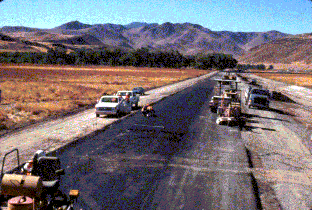
Presentation material covers the basic LCCA structure as well as the components and issues surrounding selection of data input values. User costs are increased cost to users of a highway facility and are a combination of delay, vehicle operating, and crash costs. Each of these cost components is explored and procedures are presented to determine their value. Attendees complete simple class exercises to reinforce fundamental concepts and are later introduced to a new probabilistic risk analysis approach to deal with uncertain data inputs.
Risk analysis is a technique that exposes areas of uncertainty typically hidden in the more traditional deterministic approach to LCCA, and allows the decisionmaker to weigh the likelihood of any particular outcome actually occurring. A risk analysis approach combines probabilistic descriptions of uncertain input variables and a computer simulation technique, known as the Monte Carlo, to characterize uncertainty inherent to the analysis. The Monte Carlo simulation may be thought of as a rigorous extension of a best case, most likely, worst case scenario analysis where hundreds, even thousands, of samples are randomly drawn from input probability distributions and used to calculate separate "what-if" outcomes.
With enough samples it is possible to define an entire distribution of results showing the range of possible outcomes and the likelihood that any particular outcome will actually occur. This is exactly what the decisionmaker needs to know. With the emergence of user-friendly computer software, quantitative risk analysis concepts and techniques such as the Monte Carlo can be easily incorporated into the decision making process.
The workshop is intended for pavement design engineers, technicians, and managers responsible for conducting, reviewing, or interpreting pavement design LCCA results. However, the principals of economic analysis have broad application, so other program areas may benefit as well. Attendees are provided a notebook that includes a copy of all presentation material, class exercises, and a state-of-the-practice interim technical bulletin "Life Cycle Cost Analysis in Pavement Design" prepared by the Office of Engineering's Pavement Division. Workshops have been presented in Colorado, Connecticut, Georgia, Louisiana, Massachusetts, Nevada, New Hampshire, Ohio, and Texas. Future workshops are listed in the following table.
| Date | Location | Contact | Phone |
|---|---|---|---|
| April 6-7 | Brooklandville, MD | Joe Huerta | 410-962-0077 ext. 3056 |
| April 14-15 | Springfield, IL | Keith Herbold | 708-283-3548 |
| April 28-29 | Montpelier, VT | Max Grogg | 518-431-4224 ext. 223 |
| May 5-6 | Richmond, VA | Joe Huerta | 410-962-0077 ext. 3056 |
Additional information may be obtained from the DP 115 web site www.hend.com/dp115. From this site it is possible to download workshop presentation material as well as locate upcoming workshops.
- James Walls, (202) 366-1339, james.walls@fhwa.dot.gov
The Colorado DOT hosted a Strategic Highway Research Program (SHRP) High Performance Concrete (HPC) Showcase in February. Approximately 250 attendees representing State DOTs, academia, consultants, fabricators, ready-mix concrete suppliers, and FHWA took part in this showcase that focused on an HPC bridge project in Colorado.
Project I-25 over Yale Avenue in Denver featured adjacent box girder sections. The new two-span structure replaces an existing four-span tee-girder bridge on this heavily traveled Interstate highway near the downtown area. The use of HPC in the box girders enabled Colorado DOT to maintain all lanes of traffic throughout the construction period, and the reduction in the number of spans allowed room for additional turning lanes on Yale Avenue.
HPC provided additional benefits in the new structure. The higher concrete strength used in the girders permitted longer spans and improved the under-bridge clearance without significantly affecting the grades of either I-25 or Yale Avenue. That allowed the work to be performed within the existing right-of-way. Also, low permeability concrete was specified for the bridge deck with the expectation that it will be more durable and longer lasting.
In addition to presentations on the Colorado HPC Bridge Project, the showcase included presentations on the Georgia, Ohio, and Washington State HPC Bridge Projects. A report was made on the status of HPC research on bridges in Minnesota. Contractor and concrete girder fabricator presentations and a field trip to the bridge site and the prestressed concrete plant were also part of the showcase.
- Terry Halkyard, (202) 366-6765, terry.halkyard@fhwa.dot.gov
A fiber optic strain gauge system is measuring the different stresses on a box girder that is being used as a cantilever, rather than a simple beam on a bridge in Switzerland. The system, developed for TFHRC under an interagency agreement with the Naval Research Laboratory, consists of a 32-sensor array based on the Bragg grating principle. The bridge, the Viaduct de Vaux, located near Lausanne, Switzerland, is a box-girder steel and concrete design. During construction, the girder is extended from one pier to another, a distance of over 100 m. In this extension phase, the girder experiences a different set of stresses than in regular use.
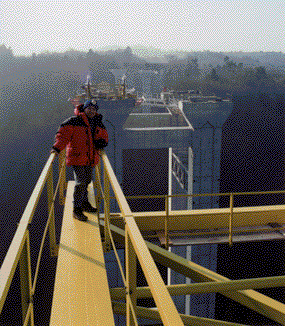
The Naval Research Laboratory team applied the sensors to the girder prior to extension. Two sensors were glued at each measurement point: one for strain measurement, the other for temperature compensation. The extension was performed during the week of February. The sensors reliably measured strains up to 400 microstrain, with an uncertainty of approximately 1 microstrain. The data indicate a complicated strain history while the girder is in the cantilever. Detailed analysis is being performed.
After the girders are all in place, the concrete deck will be poured. At that point, another set of fiber optic sensors will be embedded in the deck for long-term monitoring. This work is being carried out in collaboration with the Swiss Federal Polytechnic institute of Lausanne ( Ecole Polytechnique Federale de Lausanne).
Additional information can be found at:
- Richard A. Livingston, (202) 493-3063, dick.livingston@fhwa.dot.gov
A group of 13 countries in Latin America have pooled resources to develop a Rigid Pavement Module for the World Bank's Highway Design and Maintenance Model (HDM) software. The consortium was led by the Pan American Institute of Highways' center at the Chilean Cement and Concrete Institute. The project received technical assistance from FHWA, the Pan American Institute of Highways, and the American Concrete Paving Association.
As part of the effort, a model was developed to evaluate pavement design and maintenance strategies. Pavement Evaluator was produced in English and Spanish for broad use throughout the Americas and includes several features currently not available in any other tool. The program will perform lifecycle cost analyses for both concrete and asphalt roads. It will also let the user run multiple maintenance strategies and associated budget scenarios for planning program delivery.
The product was demonstrated during the Transportation Research Board's annual meeting in January 1998. Special demonstrations were also made for FHWA staff, and preliminary reviews show that the product bears potential for use in the United States as well as Latin America and the Caribbean. FWHA will analyze this tool from that perspective. The program is packaged as a CD-ROM operating on Windows 95.
- Greg Speier, 202-366-2095, greg.speier@fhwa.dot.gov
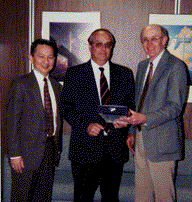
photo caption:
Dr. Juan Pablo Covarrubias, of the Chilean Cement and Concrete Institute (center), delivers FHWA's copies of Pavement Evaluator to Henry Rentz and Paul Teng from the Office of Engineering.